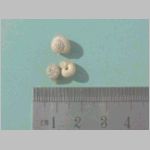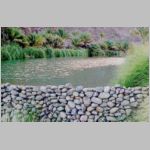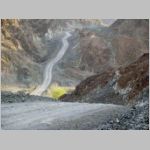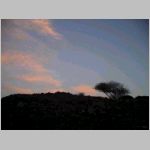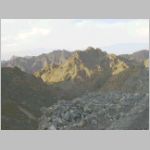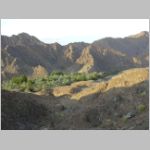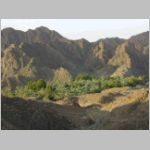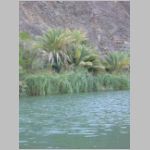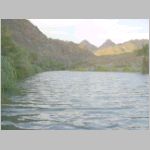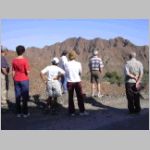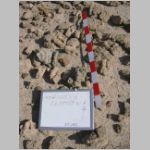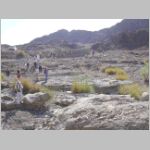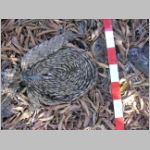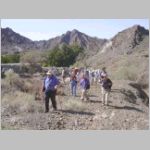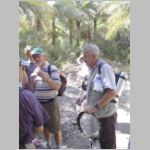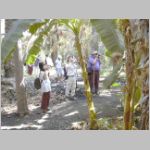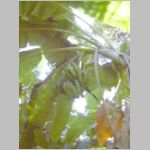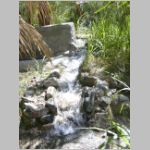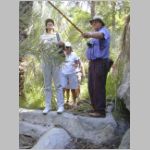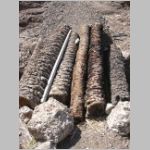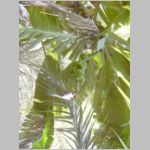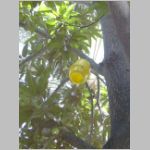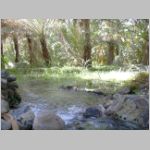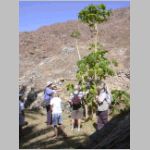Field Trip to Wadi Jazira 17 October 2003
Field Trip to Wadi Jazira 17 October 2003
by Geoff SandersonThere were 21 people who experienced one of the most memorable outings to this beautiful oasis hidden away amidst the Hajar mountains. Water gurgled through the aflaj (plural for falaj), butterflies abounded, maidenhair fern was everywhere and the weather was perfect.
Some of the curious asked about two plants; the tiny, prickly, lavender/blue flowered, thistle like (but it isn't), bluey green foliaged plant, Blepharis ciliaris (Eyelash Plant) and the larger, more obvious smokey pale green/blue, sizeable roundish leafed plant . . . Physorrhynchus chamaerapistrum ( I did warn you not to pry!). A member of the Brassicaceae family, same as cabbage, mustard, canolla, cauliflower. These plants are impressive in flower.
 The Eyelash Plant Blepharis ciliaris. Photo by Bob |
 Centaurium pulchellum. Photo by Bob |
 Nerium oleander Photo by Bob |
I prefer to wait until plants are in flower and able to be properly identified in full glory, hence my reluctance to identify from less than impressive specimens.
I encourage those of you with plant interest to buy Marijcke Jongbloed's book "Wild flowers of the United Arab Emirates", photograph plants when they are in flower, or otherwise at their best (ferns), then attempt to identify them.
I will have an evening in early March when we can identify all that we record in this way. It is far more satisfying and the names are more likely to stick.
Now that date harvest is over there are still jobs to do. Most farmers will spread manure at this time, to encourage growth and development of flowers for the next season. They also water abundantly partly to leach out salts that accumulate during the mid to late summer when irrigation is cut back to allow the dates to ripen properly. We noticed both of these activities in Jazirah Oasis.
In the meantime, while the manure is doing its thing, the date processing factories are working hard grading and packing dates for the markets of the world.
Just after Eid we will arrange a tour of one of the two date factories. Emirates Dates work the same sort of hours we work and so it is difficult to organise a suitable time. Sh. Khalifa's factory works Thursday mornings and for that reason we have visited them in the past.
Look forward to more similarly rewarding outings.
by Brigitte HowarthSeven insect orders were observed at Jazira on the 17th October and these included:
- Odonata (dragonflies and damselflies)
- Orthoptera (grasshoppers)
- Dictyoptera (cockroaches)
- Hemiptera (plant bugs, leafhoppers, scale insects)
- Diptera (two-winged flies)
- Lepidoptera (butterflies)
- Hymenoptera (bees, ants, wasps and related species)
Odonata
- Arabicnemis caerulea (Powder blue damsel)
- Orthetrum sabina (Azure (Blue) Skimmer)
- Trithemis annulata (Purple blushed darter)
- Hawker
Orthoptera
- Sphingonotus rubescens (Blue shinned grasshopper)
Dictyoptera
- Blattidae (Cockroaches) not formally identified but probably belonging to the genus Blatella and Blatta
Hemiptera
- Pentatomidae (Shield bugs) not formally identified
Diptera
- Bombyliidae (beeflies) many seen, one collected, awaiting identification
- Drosophila melanogaster (fruitfly)
- Sarcophagidae (flesh fly)
- Musca domestica (housefly)
Lepidoptera
- Spialia mangana (Arabian grizzled skipper)
- Papilio demoleus (Citrus Swallowtail)
- Pontia glauconome (Desert White)
- Colotis fausta (Salmon Arab)
- Catopsilia florella (African Emigrant)
- Eurema hecabe (Common Grass Yellow)
- Zizeeria karsandra (Asian Grass Blue)
- Freyeria trochylus (Grass Jewel)
- Junonia orithya here (Blue Pansy)
- Ypthima asterope (Common Three-Ring)
Hymenoptera
- Delta sp. (Harlequin Potter Wasp)
- Vespa orientalis (Oriental Hornet)
The most memorable insect of the day was the Common Grass Yellow. Mike Gillett explained that this was a new record for the north of Oman and he will formally record this in an article in the near future. Mike also pointed out the superb camouflage of the blue-shinned grasshopper. Memorable absences were the beetles, as no records were made.
The temperature at 10.45 am was 29°C in the shade of the oasis and the altitude at the same spot was 728 meters above sea level. There was virtually no breeze with max. windspeed measured at 0.8 Kt. Humidity was low (approx. 20%).
Other interesting faunistic finds were two species of land snails not formally identified yet (one type photographed), and a left lower jaw of a small mammal or rodent (see photograph) which also remains to be identified.
by Brien HolmesAs noted by Geoff, Jazira is often best described as an unforgettable outing; the setting of this small, isolated oasis in the barren, steep mountains is stunning.
The motion-activated cameras had been set up the evening before and a report of the events recorded and photographs of the fox are on adjoining pages. (Event details here and gallery of the fox photographs here.)
It was the first trip to Jazira for many in the group.
Water in the reservoir behind the stone weir had dropped almost half a meter overnight as a gardener had driven to the oasis early Friday morning to irrigate the plants. Nontheless, the quantity of water held behind the wall was a surprise for some. Above the reservoir were the remains of stone buildings, probably Iron Age, though there is very little pottery to assist in dating the site. The remains of at least one copper smelter are scattered around the edge of the settlement area, the scattering probably the result of the bulldozing when the track was constructed down to the water's edge.
The weir at Jazira is prone to breaking after each rainfall; on several occasions the group has visited the oasis to find the wall broken at the western end. The outfall to the falaj system is at the eastern end, hidden by dense growth.
There were sufficient cracks in the foundation of the reservoir wall to allow a constant trickle of water into small pools. A small waterfall a few meters below the reservoir was a pleasant surprise for many, as were the wadi fish.
The small group of buildings remains unchanged in recent years. The mosque and a nearby house are in the best condition while older buildings, having been repaired and renovated over the years, are in relatively good condition. Several of the buildings have locked doors though no one lives in the oasis any longer. There is at least one good example of a typical mountain house, with roof beams of split palm trunks, stone walls almost two meters high, and a roof of fine gravel. The quantity and range of pottery suggests a long and continuous period of habitation.
Immediately behind the buildings, near where the cameras were set up, is a large path of aloe vera plants. There is also a clay pit, where workmen have been recovering clay to be used in the oasis. Interestingly, there are items buried in the clay pit including old batteries and coal oil lamps, suggesting some of the clay was deposited there relatively recently (last 30 years). It is unlikely that former residents were burying refuse.
The oasis is exceptional because, in addition to the typical range of plants, Jazira includes a large growth of banana plants. Two varieties of banana are cultivated: plantain as well as the small, sweet bananas often seen in the Al Ain souq, brought from Birka and other points along the coast in Oman.
In addition to several varieties of dates, the oasis includes mango, orange, lime, pomegranate, lemon, papaya and wild fig.
The history of the Jazira oasis is linked to Khutwah, as the wadi leading downstream from Jazira flows to the western side of Khutwah. For many years, the only way in or out of Jazira was along this wadi, or by hiking over two mountain ridges. The story goes that the grandfather of the current owner declined government offers to build a road into the oasis. He feared that, once a road was built, the tourists and visitors would come and the area would be spoiled. When the man died -- he is buried alongside the road leading to the reservoir -- the road was built. In recent years, the father of the current owner lived with the laborers in the houses at Jazira but, since about 1999, there have been no permanent residents.
Photographs below by Brigitte Howarth, Geoff Sanderson, Bob Reimer and Brien Holmes.


